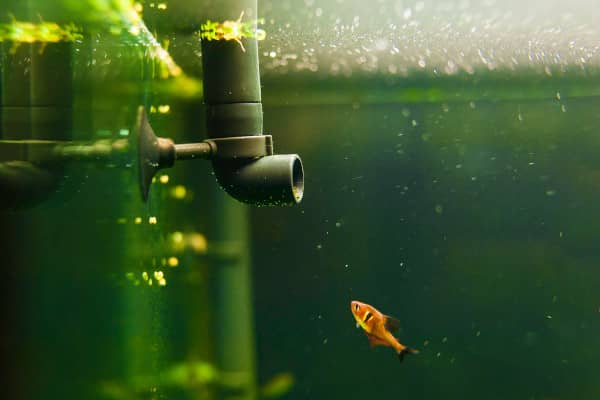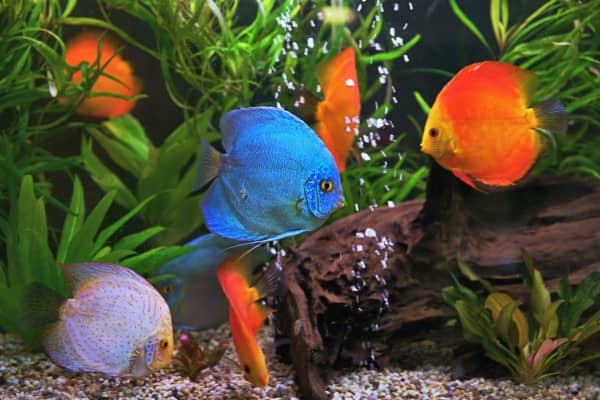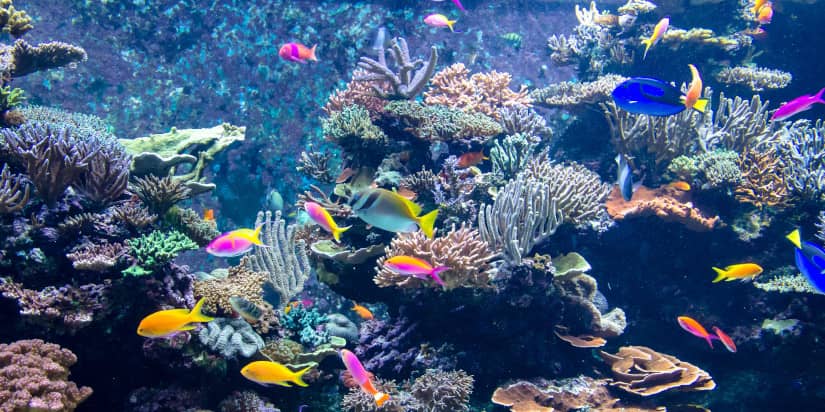Maintaining an aquarium is a lot of work. To keep your aquarium healthy, you need to monitor many different parameters in the water. Furthermore, you also need to keep your equipment running and watch out for algae and disease.
Truly, aquarium maintenance service includes a seemingly unending laundry list of tasks. It’s hard to keep track of it all, isn’t it?
That’s why we’ve put together this comprehensive guide to taking care of an aquarium. In it, we will break down what to include in your maintenance schedule and provide links to further reading on each subject.
How Do I Manage My Water Quality?
There are many steps involved in keeping your water quality high. These steps include the following:
- Cycling your tank
- Performing weekly water testing
- Regularly changing your water
- Maintaining your filtration equipment
- Understand how to clean a fish tank
We will discuss each of these steps in more detail below.

By keeping an eye on these numbers, you will help your aquarium thrive!
Cycle Your Tank
Cycling your tank is a crucial first step in saltwater and freshwater aquarium maintenance service. Before you even add any fish to your tank, you need to establish a nitrogen cycle.
During a nitrogen cycle, unhealthy elements in the water transform into good bacteria that your inhabitants need to survive. This process occurs when fish digest protein-rich food and then then expel it as ammonia-rich waste. Bacteria then convert that ammonia into nitrites and finally nitrate, which steadily accumulates until you change the water.
You should start this cycle by letting your aquarium run for at least a day without any fish. Use a cycling aid to seed the aquarium with good bacteria. After this, put a couple of your hardiest fish, like gouramis or danis, in the tank. After a week, you can add a couple more fish, but you should never add more than three fish per week.
If you avoid overfeeding or overcrowding your fish, then ammonia levels should remain at safe levels. Nevertheless, you should still regularly test the water and remove some of it if the harmful elements become too concentrated.
Novice aquarists will often take shortcuts by skipping this step or using ammonia-neutralizing supplements. Unfortunately, these shortcuts leave the bacteria without anything to eat and put the survival of your fish at risk.
Indeed, taking the time to cycle your tank can save you a lot of grief!
Perform Weekly Water Testing
Regular water testing is the bedrock of good aquarium maintenance service. For this reason, we recommend investing in water testing kits and learning to perform these tests regularly.
There are several different parameters you should keep your eye on:
- pH—Your water’s pH should remain somewhere between 6.5 and 8.2. The exact number will depend on the type of fish you have. You should also make sure your pH levels should remain stable because rapid changes in pH can kill your fish.
- Alkalinity—Low alkalinity can trigger rapid pH shifts and severely impact livestock health. So, be sure to keep alkalinity in the range of 120-300 mg/L to help maintain stable pH levels.
- Water Hardness—If water gets too hard, it can drastically increase pH levels. Therefore, you should keep water hardness in the moderate range of 100-250 mg/L to make it easier to maintain your pH.
- Chlorine and Chloramine—These chemicals may make your water safer for you to drink, but they are deadly to fish. So, make sure to put your aquarium water through a dechlorinator and test it for these chemicals regularly.
- Ammonia, Nitrite, and Nitrate—If these compounds build up too much in your tank, they can put the health of your fish at risk. To prevent this from becoming an issue, you should test your water weekly and perform regular water changes.
- Salinity—If you have a saltwater aquarium, you’ll also have to monitor the salinity of the water in your tank. You should be aware of the preferred levels of each of your fish and aim for the happy medium between them.

Regularly test the water to ensure your filtration system is working properly.
Perform Regular Water Changes
Testing your water means nothing if you’re not adjusting it based on the test results. The best way to adjust is by performing weekly and monthly water changes.
We recommend replacing 10% of the aquarium’s water with fresh dechlorinated water each week. You should also perform a monthly 25% water change and vacuum the gravel at the bottom of the tank.
Water changes are also excellent opportunities to scrub for algae, prune live plants, clean plastic decorations, and replace your pump’s air stone.
Be careful of going overboard with your water changes, though. Remember that sharp changes in the environment can do more harm than good to your fishes’ health.
Maintain Your Filtration Equipment
Keeping your filtration equipment in working order is equally crucial for aquarium maintenance service. Otherwise, all that water testing and changing will have been for nothing.
To keep your filtration system working correctly, you should inspect and clean it every month. Some of the tasks involved in this include rinsing the pre-filter and replacing the carbon and filter cartridge. You should also do any other duties specific to the type of filtration system you have installed.
Understand How to Clean a Fish Tank
Aquarium cleaning is essential, but you should also avoid doing too much or too little of it.
If you neglect cleaning your tank, then you won’t remove harmful waste and replenish helpful minerals. On the other hand, if you clean too thoroughly, you might suck and scrub away the good algae necessary to keep the nitrogen cycle going.
Instead, you should keep your fish tank cleaning to a happy medium. To do this, we recommend using a siphon tube to vacuum detritus along the bottom of your tank. You should do this once a week during your water changes.
We would also urge you not to use any cleaning products like soaps or detergents when cleaning aquarium components. These are harmful to fish and shouldn’t be used for aquarium maintenance services.
How Else Do I Keep My Fish Healthy?
Beyond maintaining water quality, there are many other ways to look out for the health of your fish.
Here are some best practices to keep in mind:
- Quarantine new fish before adding them to the tank
- Don’t house fish that don’t belong together
- Avoid improperly feeding your fish
- Maintain proper heat and light levels
- Learn how to watch for disease
We will discuss each of these in more detail below.
Quarantine New Fish Before Introducing Them to the Tank
You should quarantine any new additions in a separate tank for at least two weeks before you introduce them to the aquarium. This practice is wise because it allows you to monitor the new fish for any signs of an infection. After all, you never know what parasite or disease you may be bringing in with a new purchase.
A two-week quarantine also makes it easier for the new fish to transition into your aquarium. The gradual change makes the process less stressful for them and decreases the chances of any health or behavioral issues.
Don’t House Fish that Don’t Belong Together
Speaking of behavioral issues, let’s discuss compatibility between the different inhabitants of your aquarium. Managing their competing needs and personalities is one of the most difficult aspects of aquarium maintenance service. So, don’t set yourself up for failure by pairing inhabitants that aren’t compatible.
Sometimes, fish aren’t compatible because they have different needs regarding the aquarium conditions and water parameters. Other times, fish have behavioral conflicts and will bully, fight, kill, or even eat one another.
So, be sure to research every species you’re thinking about adding to your aquarium before you follow through. If you find that the fish probably won’t fit in, then you’ll be better off saving it for your next tank.

Aquarium maintenance service is much easier when your fish get along well together.
Avoid Improperly Feeding Your Fish
Keeping your fish on a healthy diet involves choosing the right foods and setting a healthy feeding schedule.
The types of food you choose should reflect the unique eating habits of each of your fish. For example, some fish may swim to the top of the tank to get their food while others remain at the bottom. So, if you only add flakes that float at the top of the tank, then the fish that swim to the top will eat them all while the bottom-feeders will remain underfed. So, make sure all your fish are getting their fair share.
Many fish also want variety in their diets, too. So, exclusively feeding them one food type can harm their health. Therefore, you should develop a rhythm to changing up their diet with frozen foods and other treats.
You should also be very careful not to overfeed. Novice tank owners often assume their livestock need more food when they continue to hang around the feeding area after eating. But don’t fall for this! More marine pets die due to overfeeding than due to underfeeding. So, try not to feed them more than what they can eat in one minute. Some experts even recommend skipping feeding once a week to maintain livestock health and the condition of your aquarium.

Make sure all your fish are eating their fair share!
Maintain Proper Heat and Light Levels
There are also specific temperature and lighting factors to consider when maintaining your aquarium.
As far as temperature goes, you should always keep temperatures stable in the range of 74-82ºF (23-28º C). The type of fish you own will likely have more specific temperatures best suited for them. So, you should research these and make sure to check the water temperature daily.
You should also pay close attention to lighting. After all, different organisms need different light levels at various points throughout the day. Again, make sure your inhabitants are compatible to avoid pairing a lowlight species with one that needs lots of light.
Learn How to Watch for Disease
As we mentioned before, it is crucial to spot signs during the quarantine period before adding a new fish to your tank. However, you should also remain vigilant once you’ve added the fish.
From bacterial infections to parasites to deadly algae, there are many different threats to the health of your livestock. Because of this, you should familiarize yourself with the symptoms of some of the most common illnesses for your fish. By doing this, you will equip yourself to act before it’s too late.
Do You Want More Tips on Aquarium Maintenance Services?
Many things can go wrong in your aquarium and threaten the health of your aquatic friends. We understand how overwhelming this can be for a novice aquarist. That’s why our experts are here to help!
Living Art Aquatics is a trusted custom aquarium design and aquarium maintenance service in Crystal Lake, IL. Whether you’re new to aquariums or you already have some experience, we’d be happy to help! Our experts can work with you to resolve any issues you might have.
Give us a call at (847) 737-5151, and we’ll help you make your aquarium a beautiful piece of living art!







